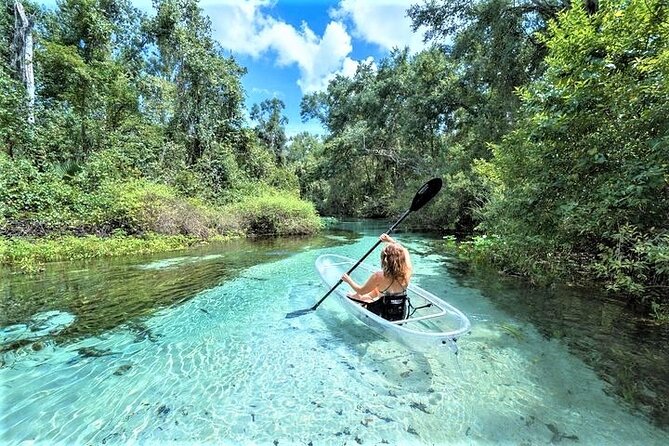Contents
- 1. Equipment and Gear
- 2. Choosing the Right Location
- 3. Essential Skills for Kayaking
- 4. Planning Your Kayaking Adventure
- 5. Safety Precautions
- 6. Kayaking in Different Seasons
- 7. Exploring Unique Kayaking Destinations
- 8. Kayaking for Wildlife Encounters
- 9. Challenges and Tips for Long-Distance Kayaking
- 10. Eco-Friendly Kayaking Practices
Picture yourself gliding through serene waters, surrounded by breathtaking landscapes and immersed in the tranquility of nature. In “Exploring the Waters: Kayaking Adventures,” you embark on a thrilling journey with a friend, navigating the elements in a tandem kayak. With just the two of you, armed with determination and a trusty radar, you explore uncharted territories and uncover hidden gems that can only be discovered through the power of paddling. Get ready to experience the thrill and serenity of kayaking, as you weave through winding waterways, conquer challenging currents, and create unforgettable memories along the way. Get your paddles ready for an unforgettable adventure!
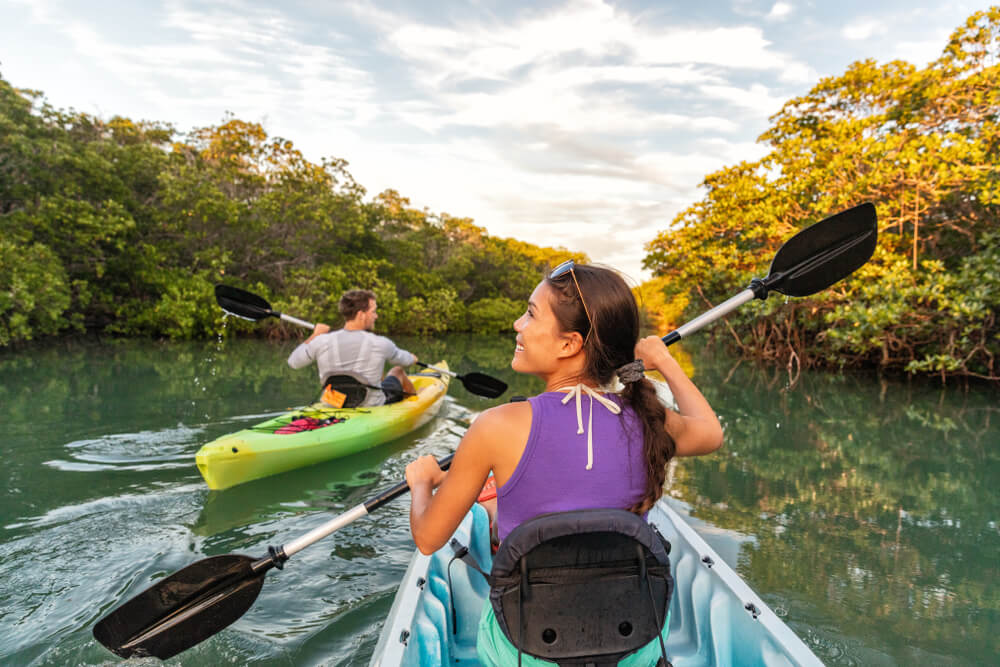
1. Equipment and Gear
1.1 Types of Kayaks
When it comes to kayaking, choosing the right type of kayak is essential. There are several types of kayaks available on the market, each designed for different purposes.
- Sit-on-top kayaks are popular among beginners and recreational paddlers. They provide stability and are easy to get in and out of, making them a great choice for exploring calm lakes and slow-moving rivers.
- Touring kayaks are designed for longer trips and can handle rougher conditions. They have a longer, narrower shape, which allows for better tracking and speed.
- Whitewater kayaks are specifically designed for navigating fast-moving rivers and rapids. They are shorter and have a more maneuverable design to tackle the challenges of whitewater.
- Sea kayaks are built for coastal and open water adventures. They have a longer length, skeg or rudder, and watertight storage compartments to accommodate long-distance paddling.
1.2 Essential Gear
Aside from the kayak itself, there are some essential gear items that every kayaker should have. These include:
- Paddle: Choose a paddle that is the right length for your height and the type of kayaking you plan to do. A lightweight and durable paddle will make your paddling more efficient and enjoyable.
- Personal Flotation Device (PFD): Safety should always be a priority, and wearing a PFD is crucial when kayaking. Make sure to choose a PFD that fits you well and provides adequate buoyancy.
- Spray Skirt: If you plan on kayaking in rough water or adverse weather conditions, a spray skirt will help keep water out of the cockpit.
- Dry Bags: Keeping your gear dry is important, especially if you’re going on multi-day trips. Invest in high-quality dry bags to protect your belongings from water.
- Waterproof Navigation Equipment: A waterproof map, compass, and GPS device are essential for navigation and ensuring you stay on course.
1.3 Safety Equipment
Safety should always be a top priority when kayaking. In addition to wearing a PFD, there are some other safety equipment items you should have on hand.
- Bilge Pump: A bilge pump is essential for removing water from your kayak in case it capsizes or if water enters the cockpit.
- First Aid Kit: Accidents happen, and having a well-stocked first aid kit can be a lifesaver in emergency situations.
- Whistle: A whistle is a simple yet effective signaling device to attract attention if you find yourself in need of help.
- Throw Bag: If you’re kayaking on rivers or whitewater, a throw bag with a buoyant rope is essential for rescuing someone in the water.
- Paddle Float: A paddle float is a device that can be attached to the end of your paddle to assist with self-rescue techniques if you capsize.
1.4 Upgrading Your Kayak with Radar
If you’re an avid kayaker looking to enhance your kayaking experience, consider upgrading your kayak with radar technology. Radar systems for kayaks provide an extra layer of safety, especially in low visibility conditions or when paddling in busy waterways. Radar can help you detect other vessels, obstacles, or even marine life that may be in your vicinity. It’s a valuable tool for increasing situational awareness and minimizing the risk of accidents. When choosing a radar system for your kayak, look for one that is specifically designed for small boats and has features like adjustable radar ranges and collision alarms.
2. Choosing the Right Location
2.1 Lakes and Reservoirs
Lakes and reservoirs are fantastic locations for kayaking, especially for beginners or those looking for a calm and serene paddling experience. These bodies of water offer smooth and glassy surfaces, making kayaking a breeze. You can leisurely explore the shoreline, take in the beautiful scenery, and even stop for a picnic along the way. Lakes and reservoirs are also ideal for recreational activities like fishing or bird watching. Just make sure to check for any boating regulations or permits required before launching your kayak.
2.2 Rivers and Streams
For those seeking a more adventurous kayaking experience, rivers and streams provide plenty of excitement. Navigating through the twists and turns of flowing water requires some paddling skills and the ability to read the current. Rivers and streams offer a dynamic environment with changing water conditions and various levels of difficulty. It’s essential to research and choose a river or stream that aligns with your skill level and comfort zone. Always be aware of potential hazards such as rocks, rapids, and strainers (obstacles that can trap a kayak).
2.3 Coastal Areas
Exploring coastal areas by kayak allows you to venture along stunning shorelines, discover hidden coves, and experience the thrill of paddling in the open ocean. Coastal kayaking requires more advanced paddling skills and an understanding of tides, currents, and weather conditions. It’s crucial to plan your route carefully, taking into account the tides and wind directions. Coastal areas often offer breathtaking views, opportunities for wildlife sightings, and the chance to paddle through sea caves or arches. Just remember to check local maritime regulations and be prepared for changing weather conditions.
2.4 Exploring Caves and Coves
If you’re looking for a unique kayaking experience, exploring caves and coves can provide a sense of adventure and mystery. Kayaking through sea caves or hidden coves offers a chance to witness stunning rock formations, marine life, and secluded beaches. However, it’s important to note that cave kayaking requires specialized skills and knowledge. Always check the tide tables, be cautious of potential hazards, and consider guided tours or experienced companions for your safety. Exploring caves and coves can be an unforgettable experience, but it’s crucial to prioritize safety and respect the fragile environment.
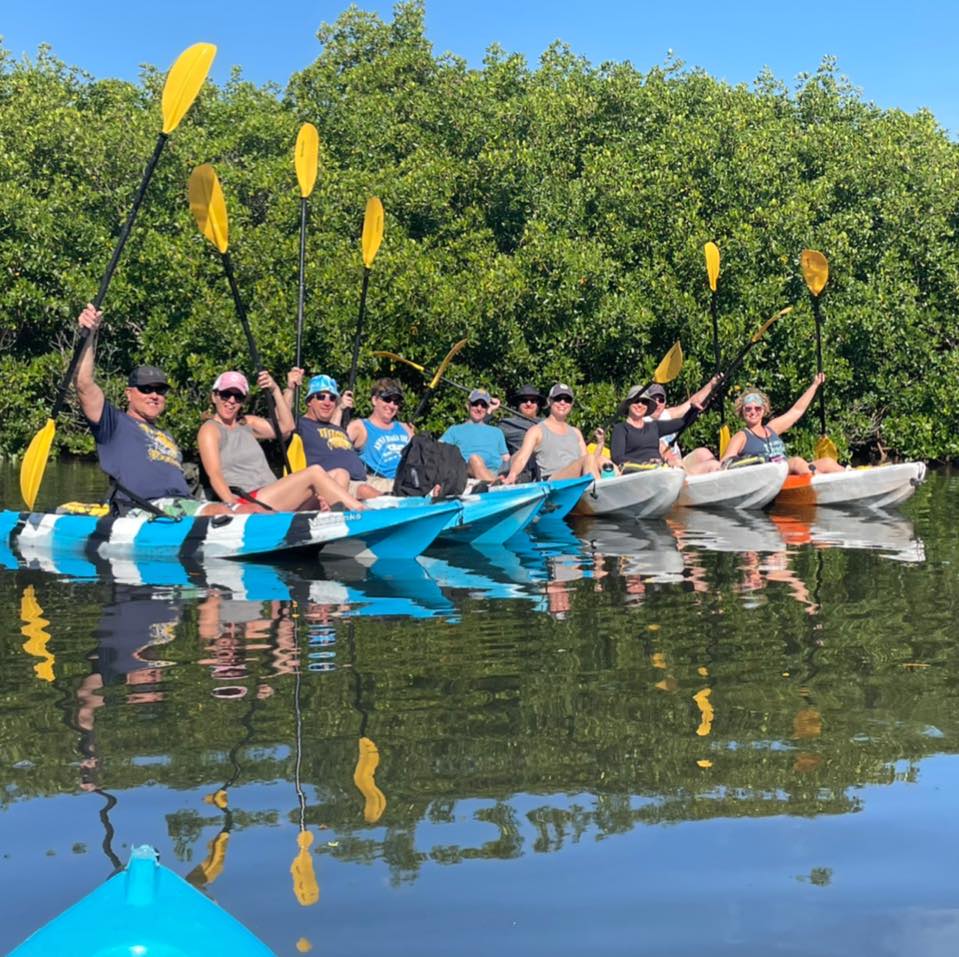
3. Essential Skills for Kayaking
3.1 Paddling Techniques
Mastering proper paddling techniques is fundamental to improving your kayaking skills and overall enjoyment on the water. Here are a few key techniques to focus on:
- Forward Stroke: This is the most basic and essential paddling technique. To execute a forward stroke, reach forward with your paddle blade, immerse it fully in the water, and then pull it back parallel to the kayak.
- Reverse Stroke: The reverse stroke is used to stop or move backward. Instead of pulling the paddle towards you, push it away from the kayak.
- Sweep Stroke: The sweep stroke is employed to turn your kayak. Start by placing the paddle blade near your feet and then sweep it in an arc away from the kayak, using your core and upper body to generate the turning motion.
- Draw Stroke: The draw stroke is useful for moving your kayak sideways or toward another object. Place the paddle blade in the water next to the kayak and pull it toward you while keeping the paddle shaft close to the kayak’s side.
3.2 Balancing and Stability
Maintaining balance and stability in your kayak is crucial for a safe and enjoyable paddling experience. Here are some tips to help improve your stability:
- Proper Seating: Sit with good posture and distribute your weight evenly. Adjust the footrests or footpegs to ensure your knees are slightly bent and provide a stable connection with the kayak.
- Active Core Engagement: Engage your core muscles to maintain stability. Pay attention to your body’s alignment, and avoid leaning too far to one side.
- Practice Bracing: Bracing techniques involve using your paddle to support yourself and maintain balance in rough water or when encountering waves. Learn and practice low and high brace techniques to build your confidence and stability.
3.3 Navigation and Map Reading
Having navigation skills and the ability to read maps is essential for planning and executing your kayaking adventures. Here’s what you need to know:
- Learn How to Read a Map: Familiarize yourself with different maps, including topographic maps, marine charts, and river guides. Understand symbols, contour lines, and other features that can help you determine your position and plan your route.
- Use a Compass: Knowing how to use a compass is invaluable for navigating. Learn the basics of compass navigation, such as taking bearings and understanding magnetic declination.
- Consider GPS Devices: While traditional navigation techniques are valuable, GPS devices can provide additional accuracy and convenience. Invest in a waterproof and durable GPS device specifically designed for outdoor activities.
3.4 Rescues and Self-Recovery
Knowing how to perform rescues and self-recovery techniques is crucial for being self-reliant and ensuring your safety on the water. Here are a few important rescue techniques to learn:
- Self-Rescue: If you capsize, practice self-rescue techniques like the paddle float rescue or the reentry and roll. These techniques require practice and familiarity, so take a course or seek guidance from experienced kayakers.
- Assisted Rescues: Learn how to assist others in need of rescue. Techniques like the T-rescue or the Eskimo rescue can help you and your paddling partners support each other in emergency situations.
Remember, practice these skills in controlled and safe environments before attempting them in more challenging conditions. Taking kayaking courses or joining a local kayak club can provide valuable training and opportunities to improve your skills.
4. Planning Your Kayaking Adventure
4.1 Trip Length and Itinerary
When planning a kayaking adventure, it’s essential to determine the length of your trip and create an itinerary. Consider factors such as your skill level, fitness level, and the resources available in the area. Start with shorter trips and gradually build up to longer expeditions as you gain experience and confidence. Plan your itinerary to include rest days, potential camping spots, and landmarks or points of interest along your route.
4.2 Weather Considerations
Weather conditions play a significant role in determining the feasibility and safety of your kayaking adventure. Pay attention to weather forecasts, including wind speed, wave height, and any storm systems approaching the area. Be prepared to adjust your plans if the weather deteriorates, and always prioritize your safety. It’s also important to familiarize yourself with the signs of hypothermia and know how to prevent or treat it in case of cold weather or water conditions.
4.3 Tides and Currents
If you’re kayaking in coastal areas or near estuaries, understanding tides and currents is crucial for planning your trip and navigating safely. Consult tide tables to determine the best times for launching and returning, as well as to avoid strong currents or excessively low tides. Plan your route accordingly, taking advantage of favorable currents and avoiding areas with potential hazards, such as strong tidal races or standing waves.
4.4 Wildlife and Environmental Factors
While enjoying the beauty of nature is a highlight of kayaking, it’s important to respect wildlife and their habitats. Here are a few considerations when interacting with wildlife:
- Maintain Distance: Observe wildlife from a safe distance to avoid causing stress or disturbance. Use binoculars or a telephoto lens to get a closer look without intruding on their natural behavior.
- Leave No Trace: Practice the “Leave No Trace” principles by minimizing your impact on the environment. Pack out all trash, dispose of waste properly, and avoid damaging vegetation or disturbing nesting areas.
- Comply with Local Regulations: Familiarize yourself with any regulations specific to the area you’re kayaking in, such as marine protected areas or wildlife sanctuaries. Follow the guidelines to ensure the protection of the environment and its inhabitants.
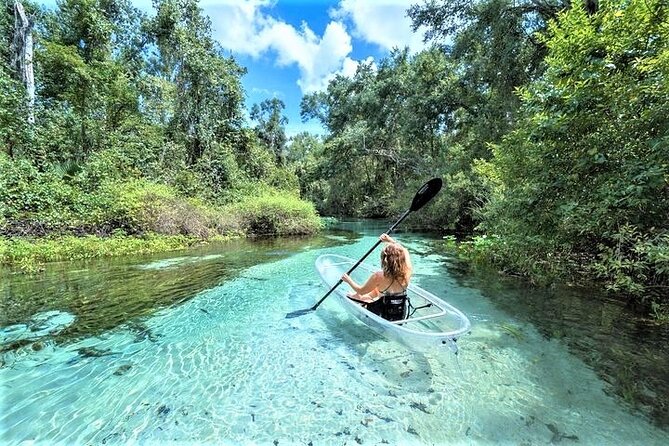
5. Safety Precautions
5.1 Check Weather Conditions
Before heading out on a kayaking adventure, always check the weather conditions. Pay attention to wind speed, wave height, and any severe weather warnings or advisories. If the weather conditions are unfavorable or if there’s a chance of storms, it may be best to postpone your trip. Remember, it’s better to be safe than sorry.
5.2 Wearing Personal Flotation Devices (PFDs)
Wearing a personal flotation device (PFD) is not just a recommendation – it’s a crucial safety precaution. A PFD can save your life in case of an accident or unexpected capsize. Make sure to choose a PFD that fits you properly and is Coast Guard approved. Wear it at all times while on the water, even if you consider yourself a strong swimmer. Accidents can happen to anyone, and a PFD can provide the extra buoyancy and support needed to stay afloat.
5.3 Communication Devices
Having reliable communication devices when kayaking can be a lifesaver, especially in case of an emergency. Consider carrying a waterproof VHF radio or a handheld marine radio to communicate with other boaters or call for assistance if needed. Additionally, having a whistle or a signaling mirror can be helpful for attracting attention or alerting others to your presence.
5.4 Buddy System
Whenever possible, it’s a good idea to kayak with a buddy or in a group. The buddy system provides an extra layer of safety, as you can watch out for each other and help in the event of an emergency. If kayaking alone is unavoidable, make sure to inform someone of your trip plans, including your intended route, expected return time, and emergency contact information. This way, if something goes wrong, help can be alerted promptly.
6. Kayaking in Different Seasons
6.1 Spring Explorations
Spring is a great time to go kayaking, as the weather starts to warm up, and nature comes to life after the winter months. Consider exploring lakes and rivers during this season, as the waters are generally calmer and less crowded. Spring also brings the opportunity to witness blooming flowers, migratory birds, and rejuvenated landscapes. Just be prepared for potentially cooler water temperatures and variable weather conditions. Always dress appropriately, wear layers, and pack a dry change of clothes to stay comfortable in case of unexpected dips in the water.
6.2 Summer Escapes
Summer is the prime season for kayaking adventures, as the weather is generally warmer and more predictable. With longer daylight hours and pleasant water temperatures, you can plan longer trips and enjoy leisurely paddling. Take advantage of the summer months to explore coastal areas, where you can soak up the sun, paddle along sandy beaches, and take refreshing dips in the ocean. Just remember to stay hydrated, wear sunscreen, and be prepared for potential crowds in popular kayaking destinations.
6.3 Autumn Adventures
Autumn offers a stunning backdrop for kayaking adventures, as the foliage changes colors and landscapes transform into a vibrant tapestry of red, orange, and gold. This season is ideal for exploring rivers or lakes surrounded by forests, allowing you to immerse yourself in the beauty of nature. However, as temperatures start to drop, it’s important to dress in layers and be aware of changing weather patterns. Autumn can bring unpredictable weather conditions, so always check the forecast and be prepared for sudden temperature changes or inclement weather.
6.4 Winter Expedition Tips
Winter kayaking is a unique experience that offers solitude and breathtaking winter landscapes. However, it requires extra precautions due to cold water temperatures and potentially harsh weather conditions. Here are some tips for winter kayaking:
- Dress for the Cold: Wear appropriate cold-water gear, including a drysuit or wetsuit, insulating layers, hat, gloves, and neoprene booties. Dressing properly will help prevent hypothermia and keep you comfortable.
- Be Mindful of Ice: Avoid kayaking in areas with ice cover unless you have proper training and experience in ice navigation. Ice can be unpredictable, and falling through thin ice can be life-threatening.
- Choose Sheltered Waterways: Opt for sheltered lakes, calm rivers, or protected bays when kayaking in winter. Avoid exposed coastal areas, where high winds and waves can pose additional risks.
- Take Shorter Trips: Winter days are shorter, so plan your trips accordingly. Paddling in cold conditions can be more physically challenging, so be mindful of your energy levels and avoid overexertion.
Always assess the risks involved in winter kayaking and make informed decisions based on your skill level and experience. Consider taking a cold water safety and rescue course before venturing into winter kayaking.
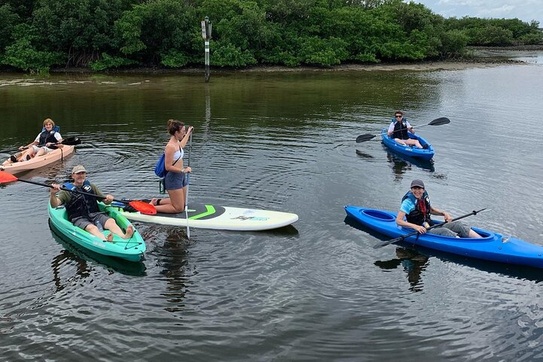
7. Exploring Unique Kayaking Destinations
7.1 Kayaking Through Glacial Waters
If you’re seeking a truly awe-inspiring kayaking experience, consider exploring glacial waters. These icy blue waters offer a surreal and mesmerizing kayaking adventure. Destinations such as Alaska, Iceland, or Patagonia boast stunning glaciers and icebergs, setting the scene for unforgettable paddling experiences. Keep in mind that kayaking in glacial waters requires careful planning, appropriate gear, and knowledge of glacial hazards. Taking a guided tour or joining an experienced group can enhance the safety and enjoyment of kayaking in these unique environments.
7.2 Discovering Hidden Waterfalls
Kayaking allows you to reach places that are inaccessible by land, and one such hidden gem you can discover is hidden waterfalls. From paddling close to cascading falls to navigating through narrow canyons, the experience of kayaking near waterfalls is nothing short of magical. Destinations like Costa Rica, Oregon, and New Zealand offer opportunities to explore stunning waterfalls from the unique perspective of a kayak. While the excitement and beauty are unmatched, always assess the risks involved, including potential strong currents or falling debris.
7.3 Navigating Whirling Rivers
For adrenaline seekers and experienced kayakers, navigating whirling rivers provides an exhilarating adventure. These rivers are characterized by fast-moving water, rapids, and challenging obstacles. Destinations like the Colorado River in the Grand Canyon, the Futaleufú River in Chile, or the Zambezi River in Africa offer thrilling whitewater kayaking experiences. It’s crucial to have the necessary skills, knowledge, and appropriate gear when tackling such demanding river systems. Consider taking advanced kayaking courses or hiring experienced guides to ensure your safety and maximize the enjoyment of navigating whirling rivers.
7.4 Coastal Safaris
Kayaking along coastal areas offers a unique way to explore diverse marine ecosystems and witness incredible wildlife. Coastal safaris allow you to paddle close to cliffs, rock formations, and secluded beaches, with the possibility of encountering marine life such as dolphins, seals, or even whales. Destinations like Vancouver Island in Canada, the Dalmatian Coast in Croatia, or the Great Barrier Reef in Australia provide ample opportunities for unforgettable coastal kayaking adventures. It’s essential to plan your trips around local marine regulations, be respectful of wildlife, and practice responsible and eco-friendly kayaking techniques.
8. Kayaking for Wildlife Encounters
8.1 Bird-Watching Excursions
Kayaking offers a unique and unobtrusive way to get up close to a wide range of bird species. Paddling silently through marshes, wetlands, or coastlines can provide opportunities to observe birds in their natural habitats. Bring along a pair of binoculars, a field guide, and a camera to enhance your bird-watching experience. Some popular bird-watching kayaking destinations include the Everglades in Florida, the Danube Delta in Romania, or the Hauraki Gulf in New Zealand. Be respectful of nesting areas, migration patterns, and any protected habitats to ensure the well-being of the birds.
8.2 Spotting Marine Life
Kayaking offers a fantastic vantage point for observing marine life, from playful dolphins to majestic Manatees and marine birds. Coastal areas, estuaries, and even certain lakes provide opportunities to encounter diverse marine species. Destinations like the Sea of Cortez in Mexico, the Ningaloo Reef in Australia, or the San Juan Islands in Washington State are renowned for their rich marine ecosystems. Stay at a safe distance, respect wildlife boundaries, and avoid disturbing their natural behavior. Remember, observing marine life from a kayak should always be a passive and non-intrusive experience.
8.3 Meeting River Otters and Beavers
Paddling along rivers and calm lakes gives you the chance to encounter fascinating river otters and beavers in their natural habitat. These semi-aquatic mammals are known for their playful behavior and unique adaptations. Look for signs such as slides, tracks, or lodges to determine their presence in an area. Destinations like Yellowstone National Park in the United States, the Scottish Highlands, or the Canadian Rockies offer opportunities to spot these charismatic creatures. Maintain a respectful distance and avoid disturbing their routines to ensure their well-being and the preservation of their habitats.
8.4 Encounters with Seals and Sea Lions
Kayaking in coastal areas can offer unforgettable encounters with seals and sea lions. These social marine mammals are curious and often approach kayaks out of curiosity. Destinations like the Galapagos Islands, the Cape Peninsula in South Africa, or the California coast are known for their abundant populations of seals and sea lions. Keep a safe distance to avoid any disturbances or possible aggressive reactions. Admire these magnificent creatures from afar, but prioritize their well-being by not approaching too closely or interfering with their natural behavior.
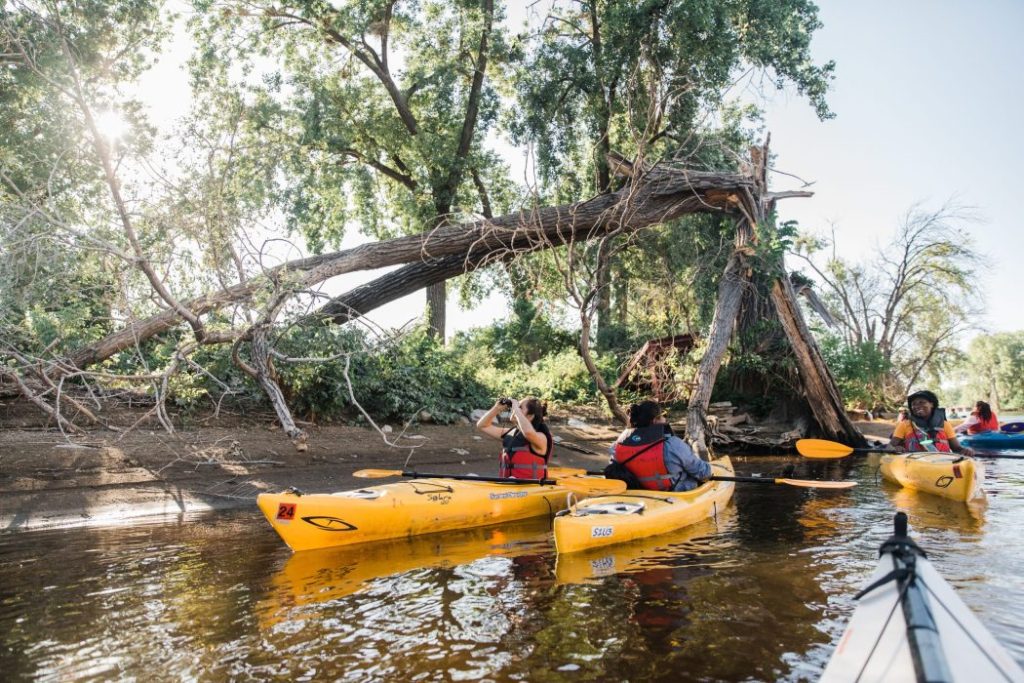
9. Challenges and Tips for Long-Distance Kayaking
9.1 Training and Fitness
Embarking on a long-distance kayaking trip requires proper training and physical fitness. Here are some tips to help you prepare:
- Build Stamina: Gradually increase your paddling distance and duration during your training sessions to build endurance.
- Strength Training: Include strength exercises that target the muscles used in kayaking, such as the core, shoulders, and arms.
- Cardiovascular Fitness: Engage in activities like running, cycling, or swimming to improve your cardiovascular endurance.
Remember to consult with a fitness professional or kayaking instructor to design a training plan that suits your goals and abilities.
9.2 Packing Efficiently
Packing efficiently and thoughtfully is essential for long-distance kayaking trips. Consider these tips:
- Lighten Your Load: Opt for lightweight gear and equipment to minimize the weight you’re carrying.
- Prioritize Necessities: Only pack essential items that you’ll use during the trip. Overpacking can slow you down and make it challenging to maneuver your kayak.
- Organize with Dry Bags: Use dry bags to keep your belongings organized and protected from water. Pack each bag according to categories like clothing, food, and camping gear.
9.3 Navigation and Wayfinding
Long-distance kayaking often involves navigating unfamiliar waters and locations. Here are some tips for successful navigation:
- Plan Your Route: Study maps, charts, and online resources to plan your route in advance. Identify landmarks, potential campsites, and points of interest along the way.
- Use GPS or Navigation Apps: Consider using a GPS device or navigation app on your smartphone to track your progress and ensure you stay on course.
- Carry Backup Navigation Tools: Always have a compass and a paper map as backup navigation tools. Electronics can fail, so it’s essential to be self-reliant.
9.4 Dealing with Fatigue and Soreness
During long-distance kayaking, it’s normal to experience fatigue and soreness. Here’s how to manage these challenges:
- Take Breaks: Plan regular breaks to rest, stretch, and refuel. Paddle at a sustainable pace and listen to your body’s signals.
- Stretching Exercises: Incorporate stretching exercises into your routine to keep your muscles loose and prevent cramping or stiffness.
- Hydrate and Fuel Properly: Drink plenty of water and eat nutritious snacks to maintain your energy levels and avoid dehydration. Carry lightweight and calorie-dense snacks that provide sustained energy.
Remember, it’s important to gradually increase your paddling distances and listen to your body. If you’re feeling excessively fatigued or experiencing pain, it’s better to take a break and rest than to risk injury or exhaustion.
10. Eco-Friendly Kayaking Practices
10.1 Leave No Trace
Practicing the principles of “Leave No Trace” is essential to enjoy kayaking while minimizing your impact on the environment. Follow these guidelines:
- Pack out all trash, including food scraps, cigarette butts, and any other waste you generate.
- Dispose of human waste properly by burying it in a cathole at least 6-8 inches deep and at least 200 feet from water sources.
- Respect vegetation and wildlife by avoiding stepping on fragile vegetation and keeping a safe distance from wildlife.
10.2 Protection of Wildlife and Habitats
When kayaking, it’s crucial to prioritize the protection of wildlife and habitats. Here’s how you can minimize your impact:
- Keep a safe distance from animals, especially nesting or mating areas, to avoid causing stress or disturbing their natural behavior.
- Avoid disturbing nesting or roosting birds by keeping your distance, especially during breeding seasons.
- Do not remove or disturb rocks, shells, or other natural objects, as they provide crucial habitats for marine life.
10.3 Responsible Camping and Waste Disposal
If your kayaking adventure includes overnight trips or camping, responsible camping practices are vital. Here’s how to minimize your impact:
- Camp on established campsites whenever possible to minimize the impact on vegetation and wildlife habitats.
- If camping in areas without established sites, camp at least 200 feet away from water sources to protect water quality.
- Pack out all trash, including food scraps and hygiene products. Leave the campsite cleaner than you found it.
10.4 Supporting Conservation Efforts
Supporting conservation efforts is an excellent way to give back to the environment you enjoy while kayaking. Consider the following actions:
- Participate in beach or river clean-ups to remove trash and debris from waterways and habitats.
- Support local conservation organizations or initiatives focused on protecting the ecosystems you explore.
- Educate yourself and others about environmental issues and responsible outdoor practices.
By actively supporting conservation efforts, you contribute to the preservation of natural areas and ensure future generations can enjoy the wonders of kayaking.

